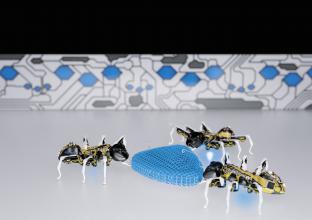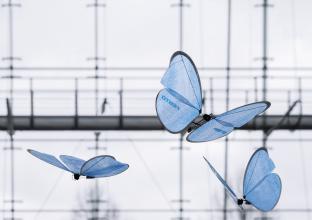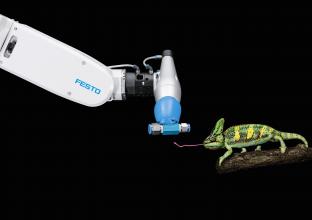
Production of the future can learn from nature
The extent to which production can learn in future from the latest projects from the Bionic Learning Network of Festo, and what special characteristics can be derived from nature, were demonstrated on the occasion of the International Press Conference at Festo’s Scharnhausen Technology Plant on 2nd and 3rd December. The questions as to whether ultra-lightweight flight objects can pave the way for new guidance and monitoring systems, and whether the adaptability of the chameleon’s tongue can provide the key to flexible gripping mechanisms, were answered in visionary approaches.
In production, automation technology assumes characteristic tasks such as the gripping, moving and positioning of goods, or the control and regulation of processes. Nature accomplishes all these tasks simply and in an energy-efficient way as a matter of course. What would be more obvious than to take a closer look at these natural phenomena and learn from them? The new projects from the Bionic Learning Network provide visionary approaches to many tasks in the production of the future. The BionicANTs and eMotionButterflies projects illustrate how networked communication between individual systems can merge to constitute an intelligent overall system. And the FlexShapeGripper demonstrates how a flexible and adaptable gripping mechanism from nature has found potential applications.
BionicANTs – highly integrated individual systems to solve a common task
For the BionicANTs, the Festo engineers have not only taken the delicate anatomy of the natural ant as a role model. For the first time, the cooperative behaviour of the creatures has also been transferred to the world of technology using complex control algorithms. “Like their natural role models, the BionicANTs work together under clear rules,” explains Dr. Heinrich Frontzek, Head of Corporate Communication. In an abstract manner, this cooperative behaviour provides interesting approaches for the factory of tomorrow. Future production systems will be founded on intelligent components, which adapt flexibly to different production scenarios and thus take on tasks from a higher control level. Dr. Frontzek says: “They communicate with each other and coordinate both their actions and movements. Each ant makes its decisions autonomously, but in doing so is always subordinate to the common objective and thereby plays its part towards solving the task at hand.”
eMotionButterflies – ultralight flying objects with collective behaviour
Flying is not only one of mankind’s oldest dreams, but also a recurring theme in the Bionic Learning Network. With the eMotionButterflies, Festo is now combining the ultra-lightweight design of artificial insects with coordinated flight behaviour in a swarm. The eMotionButterflies illustrate complex topics from the future production world such as functional integration, ultra-lightweight design and networked, real time-optimised communication between individual systems. “However, the eMotionButterflies will not fly through the factory of the future; rather, they will suggest new approaches to the functioning of a networked overall system or show us what future industrial logistics applications could look like,” emphasises Dr. Frontzek. A networked guidance and monitoring system autonomously and securely coordinates the individual flight objects in space. The communication and sensor technology used constitutes an indoor GPS system that controls the butterflies’ flight in a swarm with no risk of collision.
FlexShapeGripper – gripping modelled on the chameleon’s tongue
“The special, in fact revolutionary, feature of the FlexShapeGripper is that it can grasp, pick up and place several objects of highly diverse shapes in a single process – without the need for a manual conversion,” says Dr. Frontzek. This gripping mechanism was inspired by the working principle of the chameleon’s tongue. This is made possible by its water-filled silicone cap, which wraps itself around the items being gripped in a flexible and form-fitting manner. In future, the FlexShapeGripper could be used in any facility where multiple objects with a range of different shapes are handled at the same time – for example in the service robotics sector, for assembly tasks or when handling small components.
Festo is a global player and an independent family-owned company with headquarters in Esslingen am Neckar, Germany. Festo has set standards in industrial automation technology and technical education ever since its establishment, thereby making a contribution to sustainable development of the environment, the economy and society. The company supplies pneumatic and electrical automation technology to 300,000 customers of factory and process automation in over 35 industries. Digitalization, AI and the LifeTech sector with medical technology and laboratory automation are becoming increasingly important. The products and services are available in 176 countries. With about 20,600 employees in over 250 branch offices in around 60 countries worldwide, Festo achieved a turnover of around €3.45 billion in 2024. More than 8% of this turnover is invested in research and development. In this learning company, 1.5 % of turnover is invested in basic and further training. Festo Didactic SE is a leading provider of technical education and training and offers its customers worldwide comprehensive digital and physical learning solutions in the industrial environment.



